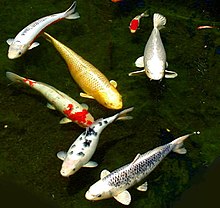Japanese carp
| Koi | |
|---|---|
 |
|
|
Domesticated
|
|
| Scientific classification | |
| Kingdom: | Animalia |
| Phylum: | Chordata |
| Class: | Actinopterygii |
| Order: | Cypriniformes |
| Family: | Cyprinidae |
| Genus: | Cyprinus |
| Species: | C. carpio |
| Subspecies: | C. c. haematopterus |
| Trinomial name | |
|
Cyprinus carpio haematopterus (Linnaeus, 1758) |
|
Koi (?, English /ˈkɔɪ/, Japanese: [koꜜi]) or more specifically nishikigoi (?, [niɕi̥kiꜜɡo.i], literally "brocaded carp"), are ornamental varieties of domesticated common carp (Cyprinus carpio) that are kept for decorative purposes in outdoor koi ponds or water gardens.
Koi varieties are distinguished by coloration, patterning, and scalation. Some of the major colors are white, black, red, yellow, blue, and cream. The most popular category of koi is the Gosanke, which is made up of the Kohaku, Taisho Sanshoku, and Showa Sanshoku varieties.
Carp are a large group of fish originally found in Central Europe and Asia. Various carp species were originally domesticated in East Asia, where they were used as food fish. Carp are coldwater fish, and their ability to survive and adapt to many climates and water conditions allowed the domesticated species to be propagated to many new locations, including Japan. Natural color mutations of these carp would have occurred across all populations. Carp were first bred for color mutations in China more than a thousand years ago, where selective breeding of the Prussian carp (Carassius gibelio) led to the development of the goldfish.
...
Wikipedia
